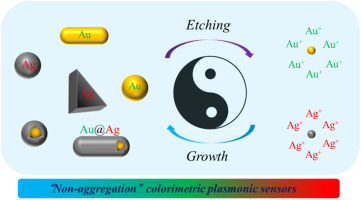Biosensors and Bioelectronics ( IF 12.6 ) Pub Date : 2018-05-09 , DOI: 10.1016/j.bios.2018.05.015 Zhiyang Zhang , Han Wang , Zhaopeng Chen , Xiaoyan Wang , Jaebum Choo , Lingxin Chen

|
Plasmonic colorimetric sensors have emerged as a powerful tool in chemical and biological sensing applications due to the localized surface plasmon resonance (LSPR) extinction in the visible range. Among the plasmonic sensors, the most famous sensing mode is the “aggregation” plasmonic colorimetric sensor which is based on plasmon coupling due to nanoparticle aggregation. Herein, this review focuses on the newly-developing plasmonic colorimetric sensing mode – the etching or the growth of metal nanoparticles induces plasmon changes, namely, “non-aggregation” plasmonic colorimetric sensor. This type of sensors has attracted increasing interest because of their exciting properties of high sensitivity, multi-color changes, and applicability to make a test strip. Of particular interest, the test strip by immobilization of nanoparticles on the substrate can avoid the influence of nanoparticle auto-aggregation and increase the simplicity in storage and use. Although there are many excellent reviews available that describe the advance of plasmonic sensors, limited attention has been paid to the plasmonic colorimetric sensors based on etching or growth of metal nanoparticles. This review highlights recent progress on strategies and application of “non-aggregation” plasmonic colorimetric sensors. We also provide some personal insights into current challenges associated with “non-aggregation” plasmonic colorimetric sensors and propose future research directions.
中文翻译:

基于贵金属纳米粒子蚀刻和生长的等离子比色传感器:策略和应用
由于在可见光范围内局部表面等离振子共振(LSPR)消光,等离子比色传感器已成为化学和生物传感应用中的强大工具。在等离激元传感器中,最著名的传感模式是“聚集”等离激元比色传感器,该传感器基于由于纳米粒子聚集而产生的等离激元耦合。在此,本文将重点介绍新兴的等离激元比色传感模式-金属纳米颗粒的蚀刻或生长会引起等离激元变化,即“非聚集”等离激元比色传感器。这种类型的传感器由于其高灵敏度,多色变化和适用于制造测试条的令人兴奋的特性而引起了越来越多的兴趣。特别感兴趣的是 通过将纳米颗粒固定在基底上的测试条可以避免纳米颗粒自动聚集的影响,并增加了存储和使用的简便性。尽管有许多描述等离子传感器发展的优秀评论,但是对基于金属纳米粒子蚀刻或生长的等离子比色传感器的关注却很少。这篇综述着重介绍了“非聚合”等离子比色传感器的策略和应用方面的最新进展。我们还提供一些个人见解,以了解与“非聚合”等离子比色传感器相关的当前挑战,并提出未来的研究方向。尽管有许多描述等离子传感器发展的优秀评论,但是对基于金属纳米粒子蚀刻或生长的等离子比色传感器的关注却很少。这篇综述着重介绍了“非聚合”等离子比色传感器的策略和应用方面的最新进展。我们还提供一些个人见解,以了解与“非聚合”等离子比色传感器相关的当前挑战,并提出未来的研究方向。尽管有许多描述等离子传感器发展的优秀评论,但是对基于金属纳米粒子蚀刻或生长的等离子比色传感器的关注却很少。这篇综述着重介绍了“非聚合”等离子比色传感器的策略和应用方面的最新进展。我们还提供一些个人见解,以了解与“非聚合”等离子比色传感器相关的当前挑战,并提出未来的研究方向。



























 京公网安备 11010802027423号
京公网安备 11010802027423号